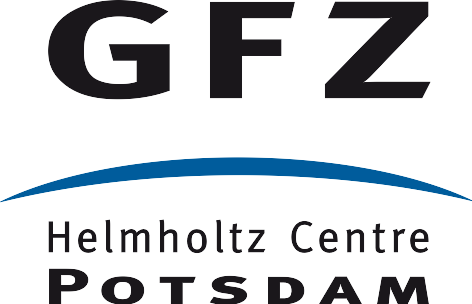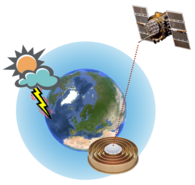GNSS data from the geodetic receivers of global and regional ground networks are operationally analysed at GFZ in near-real time. The atmospheric data products, like zenith total delay and converted integrated water vapour above the ground stations, are provided for the operational assimilation to the weather prediction models and for special scientific investigations. Currently more than 600 GNSS stations are in the operational near-real time analysis (status as of February 2024), around 300 of them are from the German SAPOS network, others are from the European EUREF network as well as from the globally distributed IGS stations.
GFZ also supports temporary atmospheric measuring campaigns with the installation and operation of GNSS ground stations and corresponding data analysis. Specific data, as, e.g., slant delays in parallel from up to 30 navigation satellites and tropospheric gradients, are currently used for studies to improve the precipitation forecast of the German Weather Service DWD.
The GNSS data of the GRUAN network (GCOS Reference Upper Air Network, www.gruan.org) of the WMO (World Meteorological Organization) are also analysed at GFZ and contribute to the GCOS (Global Climate Observing System). GNSS receivers are an integrated part of the observation equipment of the currently more than 30 globally distributed GRUAN observatories to investigate climatological variations of the Earth’s atmosphere.
References
Dick, G., Zus, F., Wickert, J., Männel, B., Bradke, M. (2023): GNSS-derived Precipitable Water Vapor for Climate Monitoring - Abstracts, EGU General Assembly 2023 (Vienna, Austria and Online 2023). https://doi.org/10.5194/egusphere-egu23-7836
Zus, F., Thundathil, R., Dick, G., Wickert, J. (2023): Fast Observation Operator for Global Navigation Satellite System Tropospheric Gradients. - Remote Sensing, 15, 21, 5114. https://doi.org/10.3390/rs15215114
Wilgan, K., Dick, G., Zus, F., Wickert, J. (2023): Tropospheric parameters from multi-GNSS and numerical weather models: case study of severe precipitation and flooding in Germany in July 2021. - GPS Solutions, 27, 49. https://doi.org/10.1007/s10291-022-01379-0
Antonoglou, N., Balidakis, K., Wickert, J., Dick, G., de la Torre, A., Bookhagen, B. (2022): Water-Vapour Monitoring from Ground-Based GNSS Observations in Northwestern Argentina. - Remote Sensing, 14, 21, 5427. https://doi.org/10.3390/rs14215427



